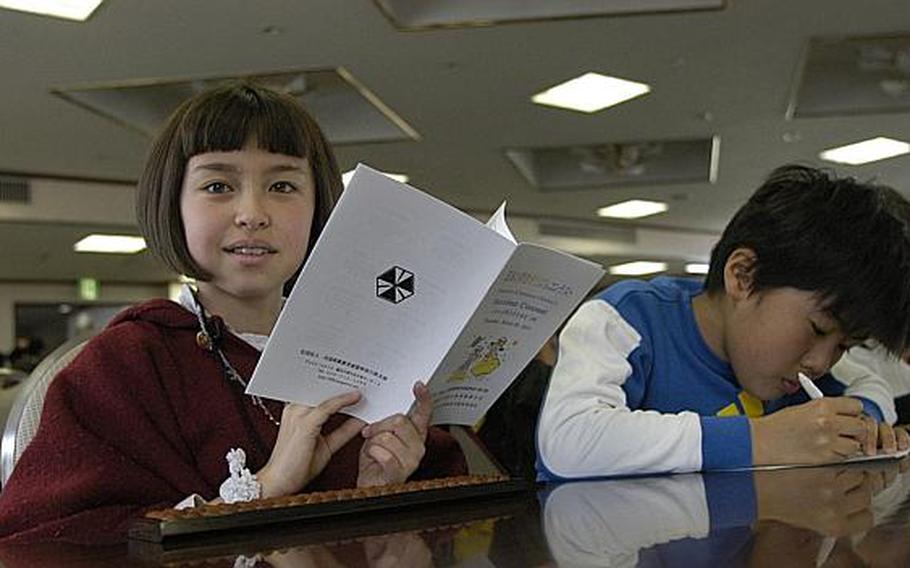
Klara Enriquez, a fourth-grader at Shirley Lanham Elementary School, takes a quick break from reading the program for the March 28, 2013, soroban event where American students and Japanese students showed off their abilities to manually computer complex series of numbers. (Charlie Reed/Stars and Stripes)
SAGAMIHARA, Japan — Start with a number — a big one.
Take 7,698,363,738, for example. Click, click, click.
Subtract 14,418,578. Click, click, click.
Add 2,447,910. Click, click, click.
Subtract 20,397,411. Click, click, click.
Add 1,927,389, 534. Click, click, click.
Got the answer?
In the time it would take the average adult to write down this lengthy series of numbers or punch them into a calculator, a group of American and Japanese elementary school students can make the computations by sliding beads up and down rods in a small wooden frame.
For the record, the answer is 9,593,385,193.
They demonstrated their skills Thursday at the kickoff event for the annual soroban competitions taking place this spring at U.S. military schools across Japan.
Soroban is the Japanese version of the abacus. Though not common in the U.S., the manual counting frame — also used for multiplication, division and more complex arithmetic — is popular in Japan and throughout Asia.
The original calculator, it was used for hundreds of years by bankers and merchants. It’s still used by shopkeepers and vendors today and is widely taught to elementary school students in Japan to help them visualize and reinforce math concepts.
“Soroban helps children better understand base tens and place values while simultaneously strengthening their concentration, patience and endurance,” said Manami Mikami, Japan District Host Nation Program Coordinator for the Department of Defense Education Activity Pacific.
DODEA schools began teaching the soroban to students in the early 1980s as part of Japanese studies courses.
Thursday’s event at Sagamihara Civic Hall was the only one where American students on the Kanto Plain compete against Japanese students. Though most of the Japanese students didn’t speak English and most of the American students didn’t speak Japanese, the soroban became their universal language.
“The soroban contests and activities are unique because they provide a meaningful cultural connection between our students and Japanese children and educators,” Mikami said.
Kouzi Suzuki, 76, who has taught the soroban to students around the world, including DODEA schools throughout the Pacific, said it helps increase connectivity between the brain’s right and left hemispheres.
“It’s real brain training,” said Suzuki, who took up the soroban at age 12.
It takes a year of study to gain a basic mastery. Eventually, he said, those who continue practicing can do complex equations even without the soroban, by visualizing the beads in their mind.
“Practice makes perfect,” he said.